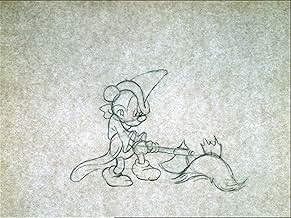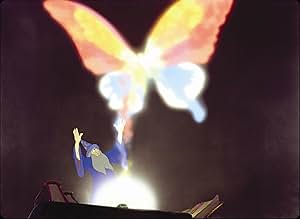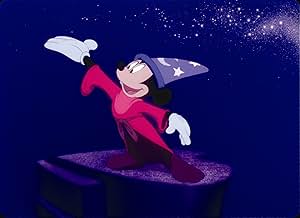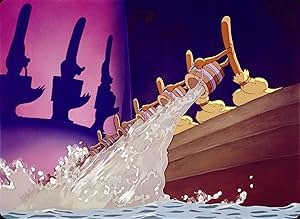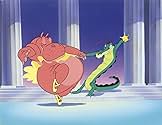Eine Collage aus animierten Interpretationen klassischer westlicher Musik.Eine Collage aus animierten Interpretationen klassischer westlicher Musik.Eine Collage aus animierten Interpretationen klassischer westlicher Musik.
- Auszeichnungen
- 9 Gewinne & 1 Nominierung insgesamt
Corey Burton
- Narrator: Deems Taylor overdubs (2000 restoration)
- (Synchronisation)
- (Nicht genannt)
Walt Disney
- Mickey Mouse (segment 'The Sorcerer's Apprentice')
- (Synchronisation)
- (Nicht genannt)
Hugh Douglas
- Narrator (1982 version)
- (Synchronisation)
- (Nicht genannt)
James MacDonald
- Percussionist
- (Nicht genannt)
Tim Matheson
- Narrator (1985 version)
- (Synchronisation)
- (Nicht genannt)
Julietta Novis
- Soloist (segment 'Ave Maria')
- (Gesang)
- (Nicht genannt)
Paul J. Smith
- Violinist
- (Nicht genannt)
Empfohlene Bewertungen
Fantasia is so educational, and I was gob smacked by how well the animation mixed with the classical music. Can I also say that Leopold Stokowski is one of the best conductor of the 20th century, right on a parallel with Herbert Von Karajan? I was listening to Sibelius's 5th symphony a few years back, and he conducted it the year before he died, and he was in his 90s. Not only that, but that was the best version of that symphony I had ever heard. Back to Fantasia then. Each piece was expertly introduced by Deems Taylor, and unlike its sequel didn't take too long.(Even the soundtrack vignette was interesting) In the sequel, almost half of the film felt like too much introduction and not enough music. Fantasia rectified that problem brilliantly:
1. Bach's Toccata- Brilliant silhouettes of the orchestra, and then masterful abstract images. The orchestra played the piece to a phenomenal standard, and I hate to say this, but I actually prefer the piece orchestrated. It was originally written for organ, you see. The best thing about Stokowski is that you see him conducting without a baton, which is exceedingly clever.
2. Tchaikovsky's Nutcracker- I recommend you see the ballet, because it is a knockout. This is coming from a classical music lover. The animation was superb in this vignette. The most impressive thing though was the fact that the finishes immediately went into the next scene, without it being hackneyed. The waltz, or Dance of the Snow Fairies, was the highlight of this vignette, reminding me so strongly of Christmas.
3. Dukas's Scorceror's Apprentice- The most famous vignette, is the only vignette to feature in the sequel. YenSid(Disney backwards) has a magic hat, which he leaves lying around, and Mickey Mouse picks it up, and encounters various problems. the animation is very good here, and while I'm not a huge fan of the piece, I still found it enjoyable.
4. Stravinsky's Rite of Spring- This is the only reason why the movie isn't a 10. This vignette is far too long It's longer than the Beethoven. It is an interesting subject, dinosaurs, but the ballet wasn't simplified enough. This was boring, and was better left out. It was only here to give some historical context. However, there was beautiful animation and some lovely instrumental solos. Stravinsky hated what the film did to his work, but anyway I don't like Stravinsky much. I had no problem with the animation or the way it was performed, it was just too long.
5. Beethoven's pastoral Symphony- This is a fantastic piece of music. I am a huge fan of Beethoven, and I have all his 9 symphonies on my IPod. My favourites are this, the Choral and the Eroica. I loved the fact that they chose a Greek mythological setting, because it looked gorgeous. My dad who is a conductor wasn't keen on the centaurs, but I loved the winged horses, Bacchus and Zeus (who competes with Chernabog as the most frightening character of the movie). This vignette was so relaxing to watch; think it as like reciting a poem.
6. Ponchielli's Dance of the Hours-This was the funniest vignette of the film, and one of the many gems of Disney. It was a bit unrealistic of course, but it was fun. At first, I was worried that the most famous scene from the opera La Giaconda, would be ruined by the animation. But it wasn't. It was perfect. Even the elephants and hippos, considering their size, danced so elegantly, I was shocked. This vignette is a must-see if you want some comedy.
7. Mussorgsky's Night on Bare Mountain- Now this was my personal favourite, as when I first watched it when I was 10, and I was terrified of Chernabog. The music is also very hard to play, as the mood is very hard to capture, but this is undoubtedly the finest recording of this music. Chernabog was genuinely frightening, and a masterful creation. And the animation, while dark, matched the music, which is enough to give you nightmares, flawlessly. It was very like a Witch's Sabbath, which was what the composer originally intended. Do you know, that for his underrated fantasy movie Legend, Ridley Scott based Tim Curry's Darkness on Chernabog? Children may find it a bit too frightening, and adults may find it inappropriate, as there is a tiny glimpse of nudity. But it was still an effective vignette, and one of my favourite Disney moments actually.
8. Schubert's Ave Maria- This is a beautiful song, and Stokowski did it justice. The harmonies and animation were perfectly captured. how could you say this was boring? The animation couldn't have been happy looking, it would have completely ruined the mood of the song. It was beautifully sung by Juillietta Novis, who was so quiet that you had to turn the volume up, but that was the intention. The thing that impressed me most, was the complete contrast of this from the Mussorgsky, so the key of Ave Maria was so well chosen. (It is sung in many different keys.) In conclusion, the most underrated of the earlier Disney efforts, is well worth watching and a true animated classic! Also I was offended by the review that said that it was the worst movie ever made, and that the people who love this movie need new taste, that is plain insulting to anyone who grew up with this film. 9/10 Bethany Cox.
1. Bach's Toccata- Brilliant silhouettes of the orchestra, and then masterful abstract images. The orchestra played the piece to a phenomenal standard, and I hate to say this, but I actually prefer the piece orchestrated. It was originally written for organ, you see. The best thing about Stokowski is that you see him conducting without a baton, which is exceedingly clever.
2. Tchaikovsky's Nutcracker- I recommend you see the ballet, because it is a knockout. This is coming from a classical music lover. The animation was superb in this vignette. The most impressive thing though was the fact that the finishes immediately went into the next scene, without it being hackneyed. The waltz, or Dance of the Snow Fairies, was the highlight of this vignette, reminding me so strongly of Christmas.
3. Dukas's Scorceror's Apprentice- The most famous vignette, is the only vignette to feature in the sequel. YenSid(Disney backwards) has a magic hat, which he leaves lying around, and Mickey Mouse picks it up, and encounters various problems. the animation is very good here, and while I'm not a huge fan of the piece, I still found it enjoyable.
4. Stravinsky's Rite of Spring- This is the only reason why the movie isn't a 10. This vignette is far too long It's longer than the Beethoven. It is an interesting subject, dinosaurs, but the ballet wasn't simplified enough. This was boring, and was better left out. It was only here to give some historical context. However, there was beautiful animation and some lovely instrumental solos. Stravinsky hated what the film did to his work, but anyway I don't like Stravinsky much. I had no problem with the animation or the way it was performed, it was just too long.
5. Beethoven's pastoral Symphony- This is a fantastic piece of music. I am a huge fan of Beethoven, and I have all his 9 symphonies on my IPod. My favourites are this, the Choral and the Eroica. I loved the fact that they chose a Greek mythological setting, because it looked gorgeous. My dad who is a conductor wasn't keen on the centaurs, but I loved the winged horses, Bacchus and Zeus (who competes with Chernabog as the most frightening character of the movie). This vignette was so relaxing to watch; think it as like reciting a poem.
6. Ponchielli's Dance of the Hours-This was the funniest vignette of the film, and one of the many gems of Disney. It was a bit unrealistic of course, but it was fun. At first, I was worried that the most famous scene from the opera La Giaconda, would be ruined by the animation. But it wasn't. It was perfect. Even the elephants and hippos, considering their size, danced so elegantly, I was shocked. This vignette is a must-see if you want some comedy.
7. Mussorgsky's Night on Bare Mountain- Now this was my personal favourite, as when I first watched it when I was 10, and I was terrified of Chernabog. The music is also very hard to play, as the mood is very hard to capture, but this is undoubtedly the finest recording of this music. Chernabog was genuinely frightening, and a masterful creation. And the animation, while dark, matched the music, which is enough to give you nightmares, flawlessly. It was very like a Witch's Sabbath, which was what the composer originally intended. Do you know, that for his underrated fantasy movie Legend, Ridley Scott based Tim Curry's Darkness on Chernabog? Children may find it a bit too frightening, and adults may find it inappropriate, as there is a tiny glimpse of nudity. But it was still an effective vignette, and one of my favourite Disney moments actually.
8. Schubert's Ave Maria- This is a beautiful song, and Stokowski did it justice. The harmonies and animation were perfectly captured. how could you say this was boring? The animation couldn't have been happy looking, it would have completely ruined the mood of the song. It was beautifully sung by Juillietta Novis, who was so quiet that you had to turn the volume up, but that was the intention. The thing that impressed me most, was the complete contrast of this from the Mussorgsky, so the key of Ave Maria was so well chosen. (It is sung in many different keys.) In conclusion, the most underrated of the earlier Disney efforts, is well worth watching and a true animated classic! Also I was offended by the review that said that it was the worst movie ever made, and that the people who love this movie need new taste, that is plain insulting to anyone who grew up with this film. 9/10 Bethany Cox.
This without a doubt the greatest animated film in history. While highly acclaimed and well-known today, it was not terribly popular when it was first released. The idea of "Fantasia" is to take great pieces of music and draw animated sequences that match them. In doing so, it reverses the purpose of a movie's score; the movie serves and matches the music, not the other way around. This set up also means that there is no typical formula plot that is present in the vast majority of movies. In the first piece, the animation is vague and abstract, but in later ones it is of definite actions, objects, and stories. The two most famous(and my favorite) parts are probably "The Sorcerer's Apprentice" and "Rite of Spring". "Fantasia" is not only the best animated film ever made, but one of the greatest films period.
10Spleen
There cannot be one verdict on "Fantasia". There must be eight: one for each of the seven segments, and an eighth for the film as a whole - for, varied though the seven segments are, they undeniably belong together. And, alas, space does not permit me to lay out all eight verdicts. I shall have to confine myself to details representative of the whole. At any rate, I shall try.
We learn the modus operandi of "Fantasia", the linking theme, in the second segment - an abridged version of Tchaikovsky's "Nutcracker" suite. (Missing are the overture and the march.) Tchaikovsky's ballet involves anthropomorphising inanimate things, plus the odd tiny animal. So does Disney's "Nutcracker". But Disney has thrown out the particular details. The Chinese Dance is danced by mushrooms (who look, but are not, Chinese); the Arabian Dance by "Arabian" goldfish; the Russian dance by "Russian" thistles and orchids. Sometimes it goes further: "Waltz of the Flowers" shows two entire changes of seasons, with leaves, fairies, seed pods, seeds, snowflakes - everything but flowers. But in ignoring the letter of the instructions Disney is perfectly true to the spirit. Indeed he is more true to the spirit than the original ballet - for, let's face it: stage ballet is a degenerate and over-formalised art, which makes some of the world's most exciting music dull as wallpaper. Disney's amazing images express Tchaikovsky's sense of motion more than earthbound dancers ever could. This, one feels, is the kind of thing ballet music was TRULY designed for. The same goes to a lesser extent for the other two pieces of ballet music on the program.
This basic device - ignoring explicit instructions, but remaining true to the spirit - is carried through into every segment. (Some segments are better than others, but none can be called a failure.) Dukas's "The Sorcerer's Apprentice" has been turned into a Mickey Mouse cartoon - but it's the best Mickey Mouse cartoon ever made; and we realise that the story of the Sorcerer's Apprentice is really the archetype that all of the best Mickey Mouse cartoons had been reaching towards, all along. The Pastoral Symphony adheres to Beethoven's program but moves everything from the woods of Central Europe to a dreamland from classical mythology. (The second movement - the section with the courting centaurs - is a failure. For once the spirit as well as the letter of Beethoven is ignored. Unfortunately some critics cannot see beyond this movement to the superb interpretations that flank it on either side.)
I doubt that so much genuine creative work has gone into a film, before or since - even if you don't count the contributions made by the composers. What's my favourite film? I really don't know. But if you tell me that I must sit in a large dark cinema for two hours; and ask me what I would like to occupy my eyes and ears over those two hours, I would answer, without hesitation, Fantasia.
We learn the modus operandi of "Fantasia", the linking theme, in the second segment - an abridged version of Tchaikovsky's "Nutcracker" suite. (Missing are the overture and the march.) Tchaikovsky's ballet involves anthropomorphising inanimate things, plus the odd tiny animal. So does Disney's "Nutcracker". But Disney has thrown out the particular details. The Chinese Dance is danced by mushrooms (who look, but are not, Chinese); the Arabian Dance by "Arabian" goldfish; the Russian dance by "Russian" thistles and orchids. Sometimes it goes further: "Waltz of the Flowers" shows two entire changes of seasons, with leaves, fairies, seed pods, seeds, snowflakes - everything but flowers. But in ignoring the letter of the instructions Disney is perfectly true to the spirit. Indeed he is more true to the spirit than the original ballet - for, let's face it: stage ballet is a degenerate and over-formalised art, which makes some of the world's most exciting music dull as wallpaper. Disney's amazing images express Tchaikovsky's sense of motion more than earthbound dancers ever could. This, one feels, is the kind of thing ballet music was TRULY designed for. The same goes to a lesser extent for the other two pieces of ballet music on the program.
This basic device - ignoring explicit instructions, but remaining true to the spirit - is carried through into every segment. (Some segments are better than others, but none can be called a failure.) Dukas's "The Sorcerer's Apprentice" has been turned into a Mickey Mouse cartoon - but it's the best Mickey Mouse cartoon ever made; and we realise that the story of the Sorcerer's Apprentice is really the archetype that all of the best Mickey Mouse cartoons had been reaching towards, all along. The Pastoral Symphony adheres to Beethoven's program but moves everything from the woods of Central Europe to a dreamland from classical mythology. (The second movement - the section with the courting centaurs - is a failure. For once the spirit as well as the letter of Beethoven is ignored. Unfortunately some critics cannot see beyond this movement to the superb interpretations that flank it on either side.)
I doubt that so much genuine creative work has gone into a film, before or since - even if you don't count the contributions made by the composers. What's my favourite film? I really don't know. But if you tell me that I must sit in a large dark cinema for two hours; and ask me what I would like to occupy my eyes and ears over those two hours, I would answer, without hesitation, Fantasia.
This is one of the truly rare, one of a kind movie going experiences, kind of in the same league as watching 2001: A Space Odyssey. I like to watch this film repeatedly; often times I'll just close my eyes and daydream, letting my own imagination go in place of whats on the screen. My favorite part is the opening sequence, with its dramatic music and free flowing imagery foreshadowing the state of the world in 1940. The end of Ave Maria is the perfect bookend to this masterpiece; death has withdrawn and peace has finally arrived. It would, but not for another five years and millions of lives. I can never watch this movie without seeing it in this context; for me its a work of art, both a part and ahead of its time.
In 1940, Walt Disney released "Fantasia", the third feature of his studio and maybe his most ambitious project, with a beautiful combination of classical music conducted by Leopold Stokowski and animation. The result is a movie that has been worshiped by every generation.
Yesterday I saw "Fantasia" again, now on the Special 60th Anniversary Edition DVD, restored and remastered with audio in THX inclusive with intermission. The program, for those that have eventually never seen or want to recall, is composed by the following:
(1) Toccata and Fugue in D Minor by Johann Sebastian Bach.
(2) Nutcracker Suite by Pyotr Ilyich Tchaikovsky.
(3) The Sorcerer's Apprentice by Paul Dukas.
(4) Rite of Spring by Igor Stravinsky.
(5) Intermission/Meet the Soundtrack.
(6) The Pastoral Symphony by Ludwig van Beethoven.
(7) Dance of the Hours by Amilcare Ponchielli.
(8) Night on Bald Mountain by Modest Mussorgsky.
(9) Ave Maria by Franz Schubert.
My vote is eight.
Title (Brazil): "Fantasia"
Yesterday I saw "Fantasia" again, now on the Special 60th Anniversary Edition DVD, restored and remastered with audio in THX inclusive with intermission. The program, for those that have eventually never seen or want to recall, is composed by the following:
(1) Toccata and Fugue in D Minor by Johann Sebastian Bach.
(2) Nutcracker Suite by Pyotr Ilyich Tchaikovsky.
(3) The Sorcerer's Apprentice by Paul Dukas.
(4) Rite of Spring by Igor Stravinsky.
(5) Intermission/Meet the Soundtrack.
(6) The Pastoral Symphony by Ludwig van Beethoven.
(7) Dance of the Hours by Amilcare Ponchielli.
(8) Night on Bald Mountain by Modest Mussorgsky.
(9) Ave Maria by Franz Schubert.
My vote is eight.
Title (Brazil): "Fantasia"
Wusstest du schon
- WissenswertesDuring production, the animators were given no instructions for coloring. Walt Disney instructed them to use any colors they wanted, which was a first.
- PatzerWhen introducing the "Pastoral" sequence, Deems Taylor mixes Greek and Roman names of deities: Bacchus, Vulcan and Diana are Roman; Zeus, Iris and Morpheus are Greek. Apollo is the only one whose Greek and Roman equivalents have the same name.
- Zitate
Mickey Mouse: [Pulling on Stokowski's coat] Mr. Stokowski! Mr. Stokowski!
[Mickey whistles to get Stokowski's attention]
Mickey Mouse: My congratulations, sir!
Leopold Stokowski: [shaking hands with Mickey] Congratulations to you, Mickey!
Mickey Mouse: Gee, thanks! Hehe! Well, so long! I'll be seeing ya!
Leopold Stokowski: Goodbye!
- Crazy CreditsThere are no closing credits of any kind. Not even the words "THE END" appear on the screen.
- Alternative VersionenBefore the 1990 re-release, the film was shown with no credits other than the title and the RKO logo. Leopold Stokowski received a written credit only on the posters advertising the film. In the film's original roadshow release, not even the title was shown at the beginning of the film - that was saved for the intermission break.
- VerbindungenEdited into A World Is Born (1955)
- SoundtracksToccata and Fugue in D Minor, BWV 565
Composed by Johann Sebastian Bach
Orchestrated by Leopold Stokowski (uncredited)
Played by The Philadelphia Orchestra
Conducted by Leopold Stokowski
Top-Auswahl
Melde dich zum Bewerten an und greife auf die Watchlist für personalisierte Empfehlungen zu.
Details
- Erscheinungsdatum
- Herkunftsland
- Offizieller Standort
- Sprache
- Auch bekannt als
- Fantasía
- Drehorte
- Produktionsfirmen
- Weitere beteiligte Unternehmen bei IMDbPro anzeigen
Box Office
- Budget
- 2.280.000 $ (geschätzt)
- Bruttoertrag in den USA und Kanada
- 76.408.097 $
- Eröffnungswochenende in den USA und in Kanada
- 980.798 $
- 10. Feb. 1985
- Weltweiter Bruttoertrag
- 76.414.517 $
- Laufzeit2 Stunden 4 Minuten
- Farbe
- Sound-Mix
- Seitenverhältnis
- 1.37 : 1
Zu dieser Seite beitragen
Bearbeitung vorschlagen oder fehlenden Inhalt hinzufügen





